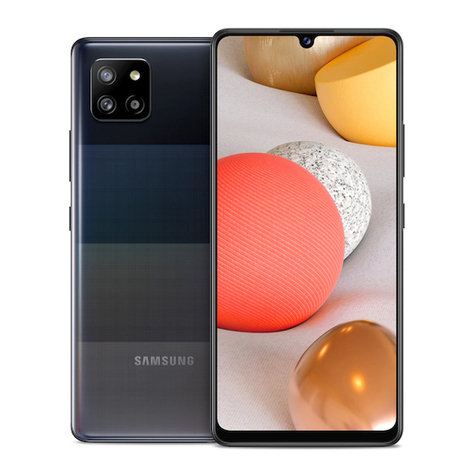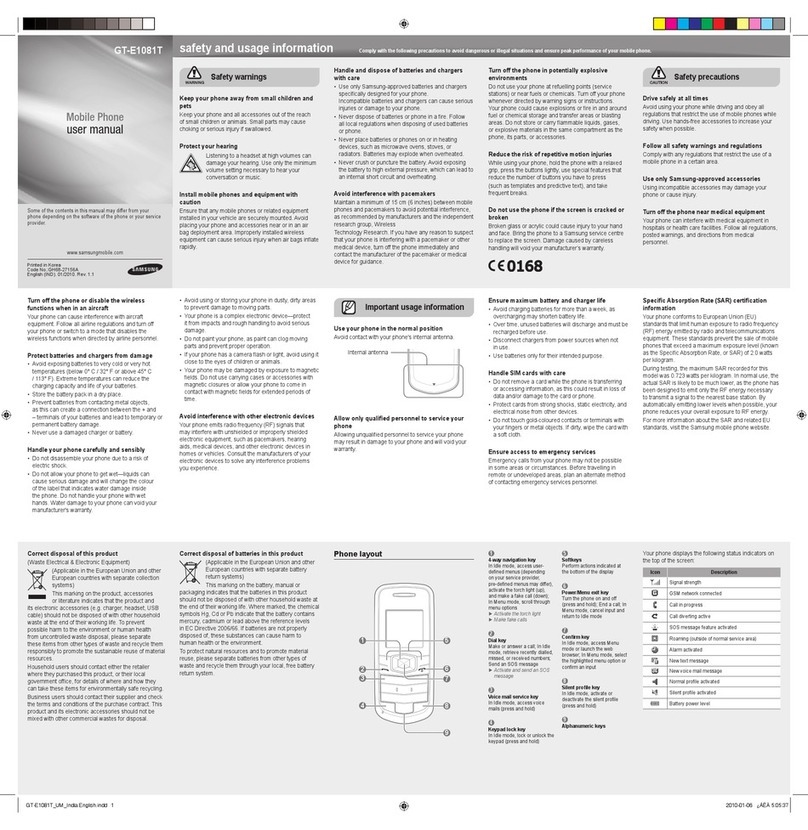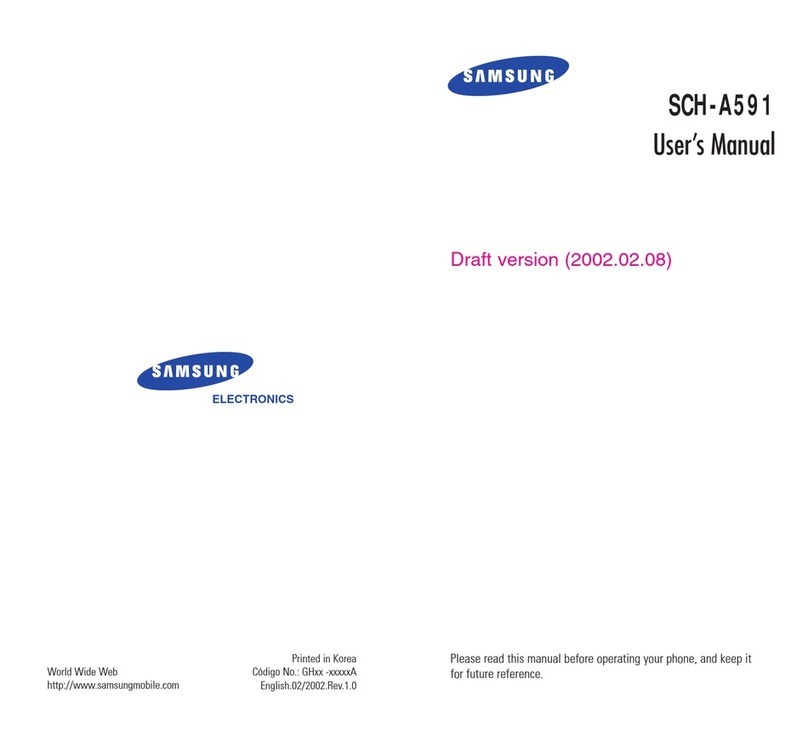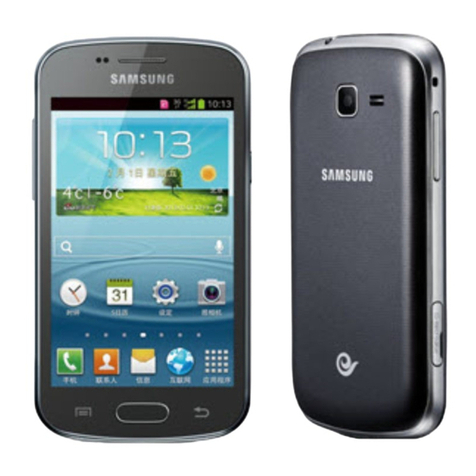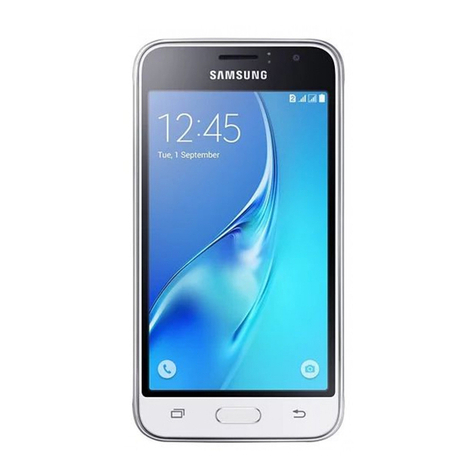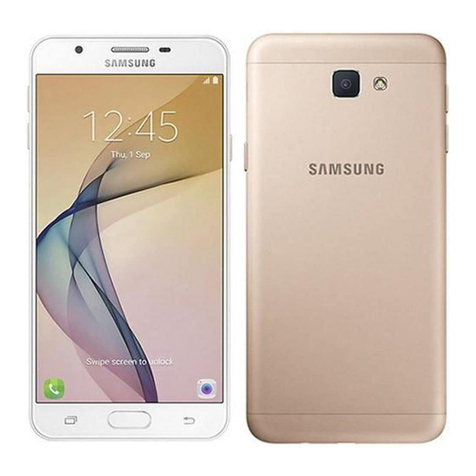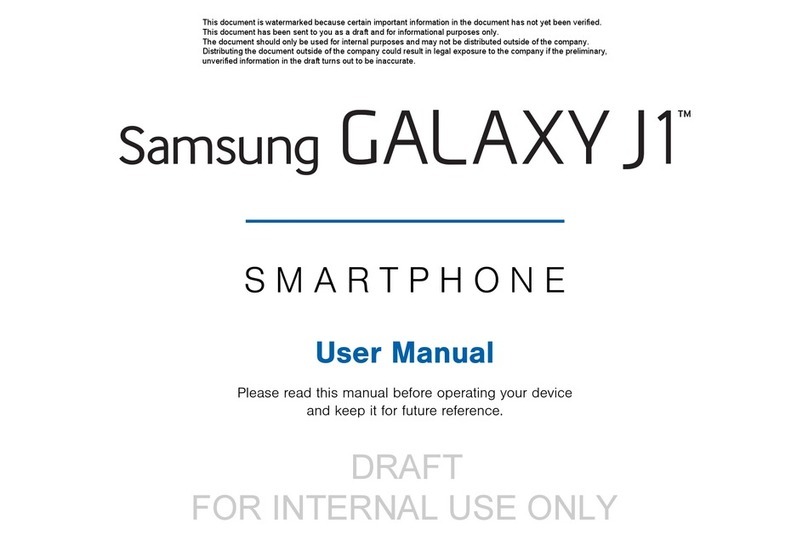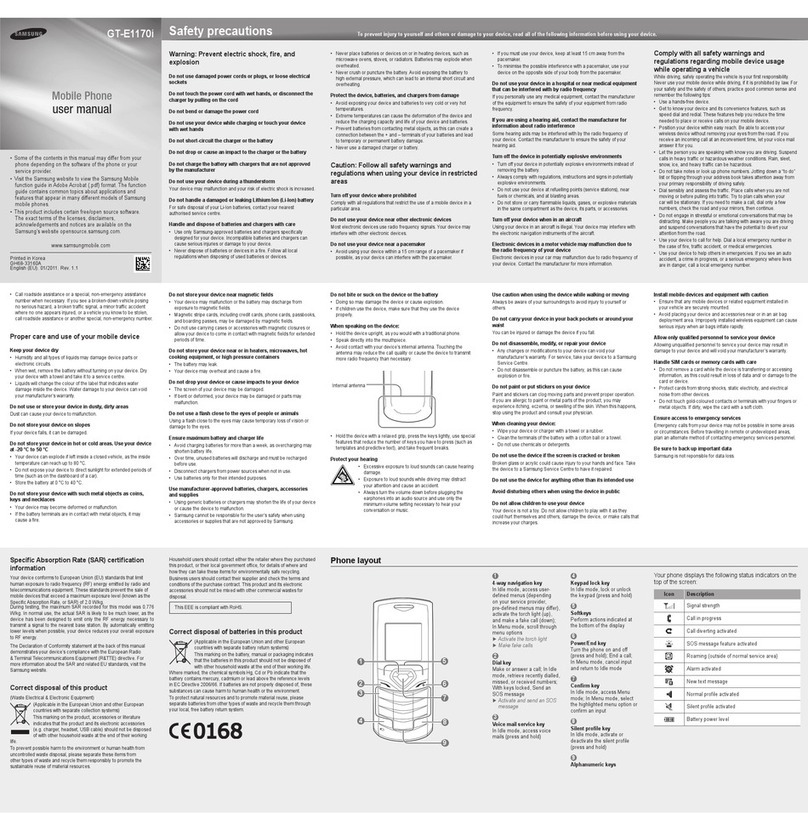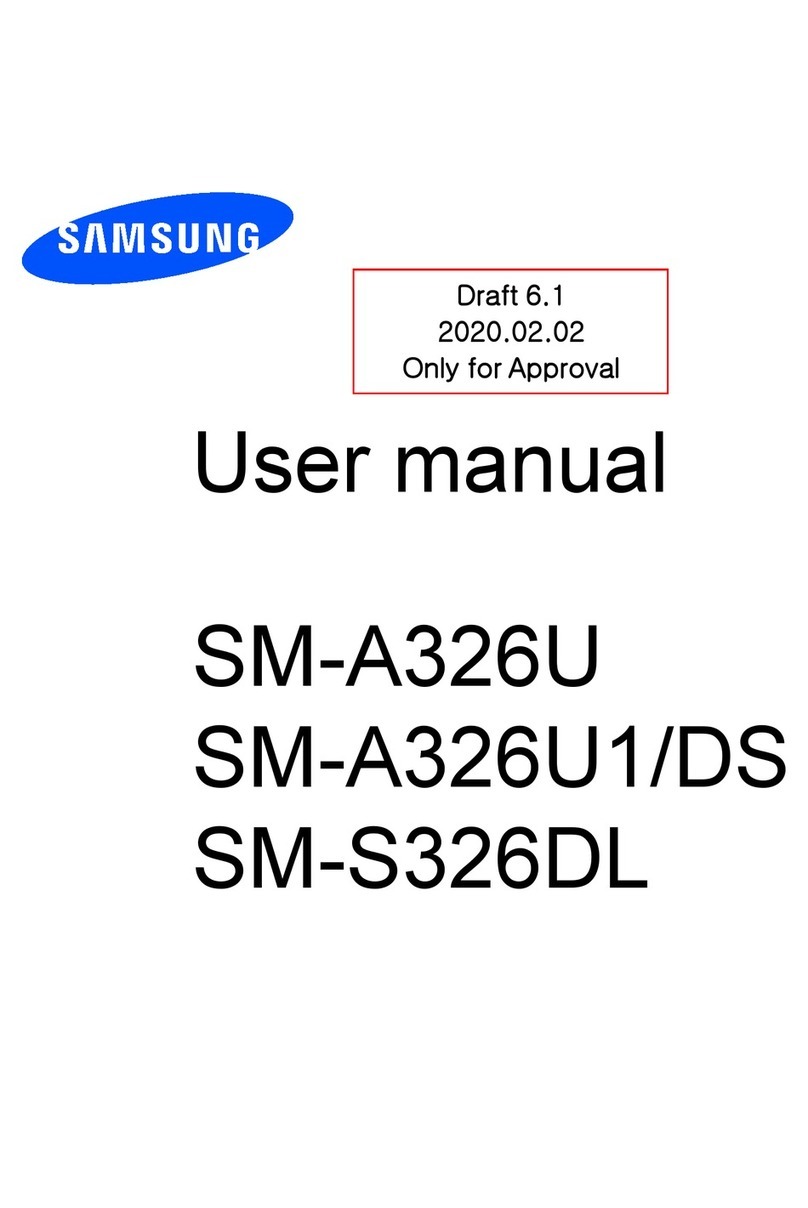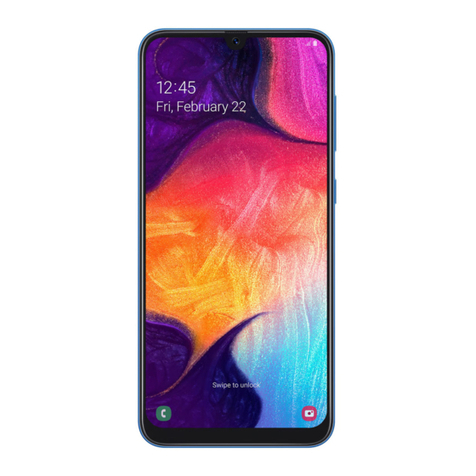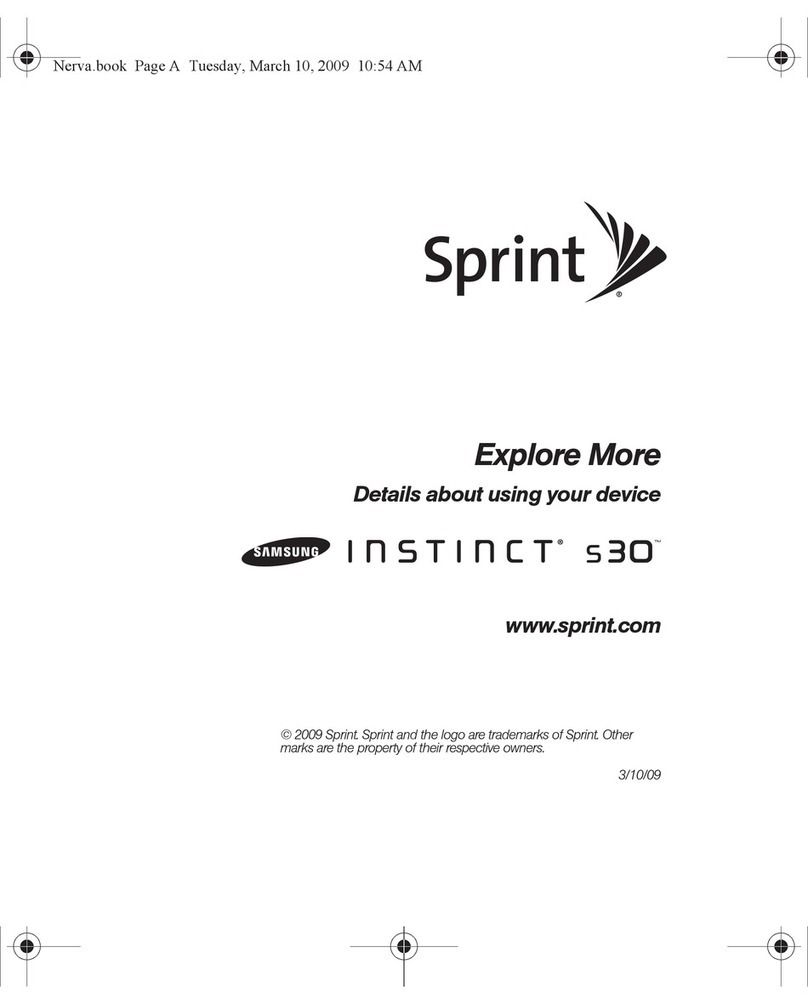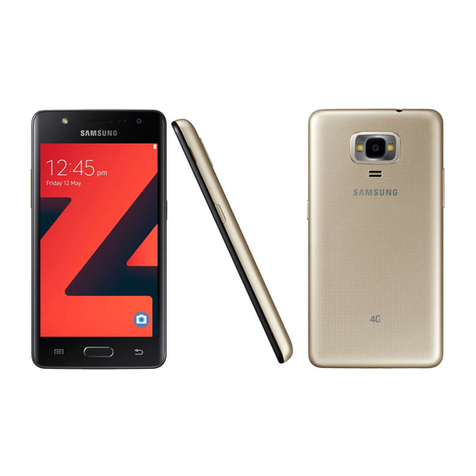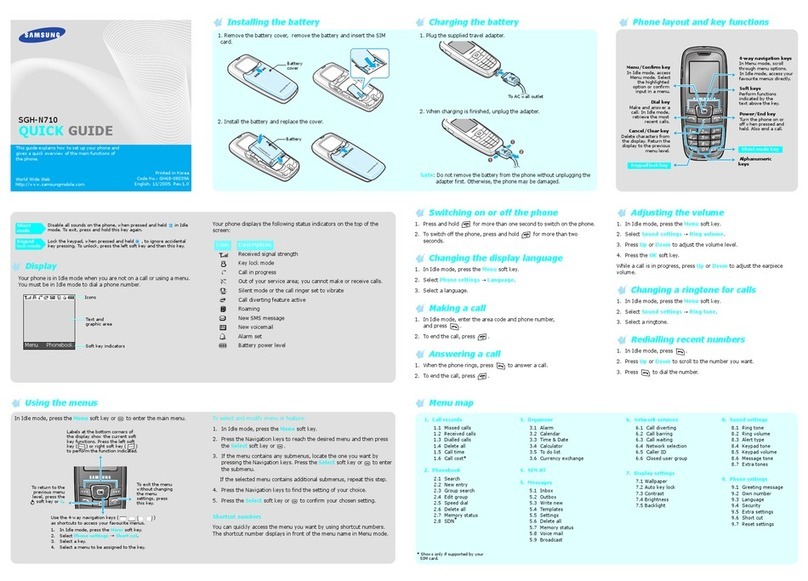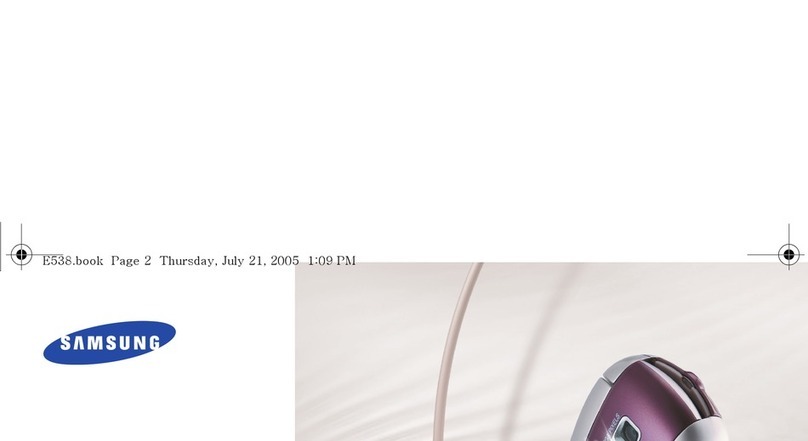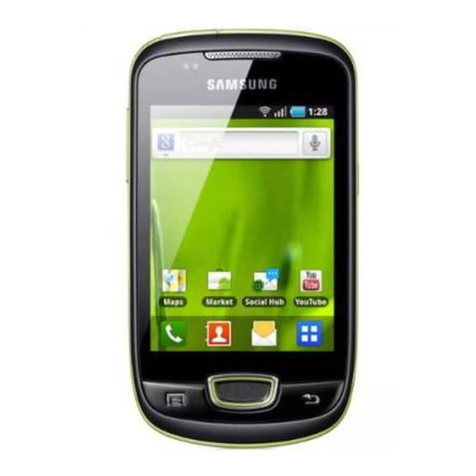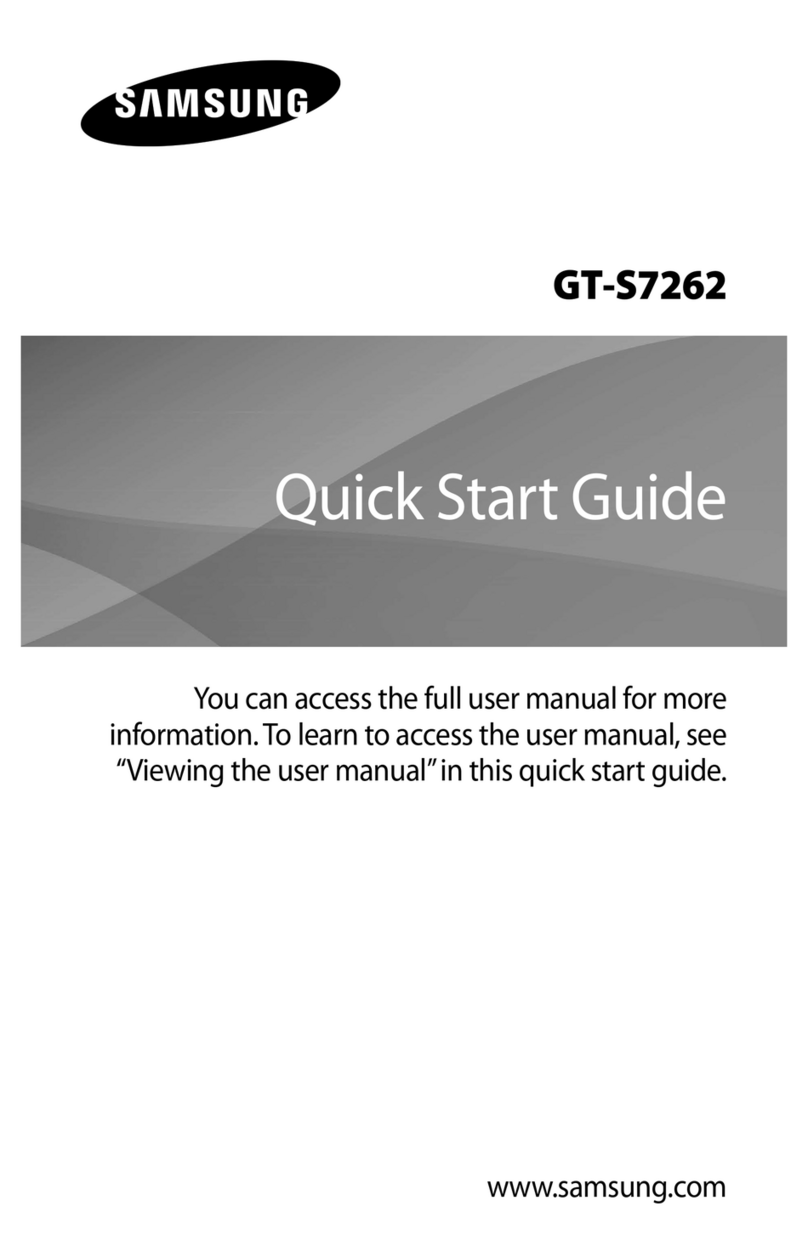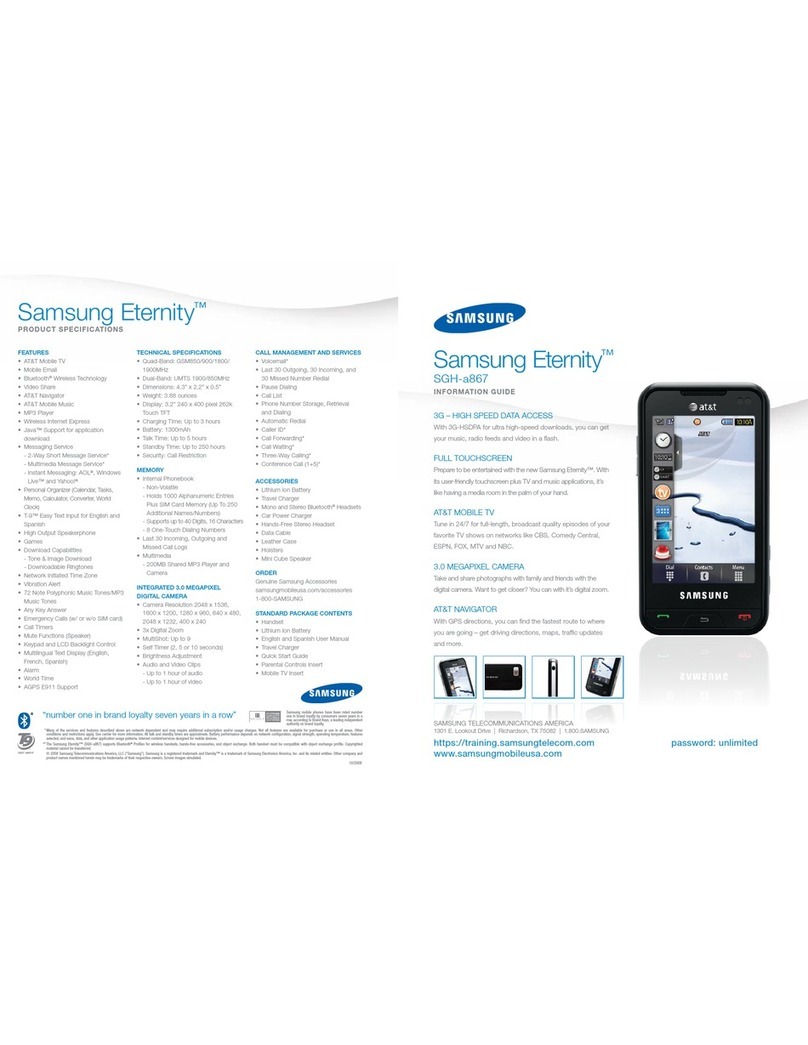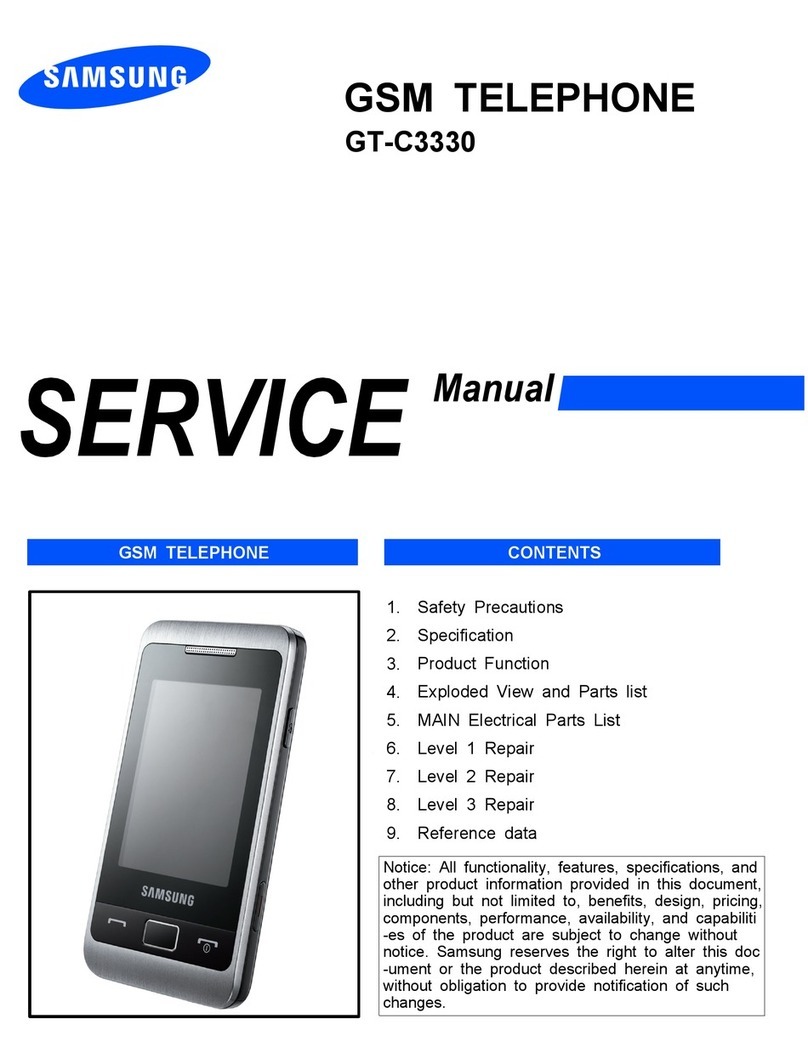
Number mode
Press the keys corresponding to the digits you want.
Symbol mode
Press the keys corresponding to the symbols you want and press the
OK
soft key. You can press
Up
or
Down
to display more symbols.
Tips for entering text
• To move the cursor, press the Navigation keys.
• To delete characters one by one, press
C
. To delete all of the characters,
press and hold
C
.
• To insert a space between characters, press .
• To change case in T9 mode or ABC mode, press the right soft key.
• To enter punctuation marks in T9 mode or ABC mode, press
1
or
0
.
Sending an SMS message
1. In Idle mode, press the
Menu
soft key .
2. Select
Text messages
→
Create
3. Enter the message text.
4. Press the
Options
soft key and add items using the following options:
•
Add media
: add sounds, images, or animated images.
•
Add emoticon
: add emoticons.
•
Preset messages
: add text templates.
5. Press the
Options
soft key and select
Send
.
6. Select an empty location.
7. Enter a destination number and press the
OK
soft key.
8. Press the
Send
soft key to send the message.
Taking a photo
1. In Idle mode, press
Right
and select
Take photos
.
2. Aim the lens at the subject and make any desired adjustments.
3. Press to take a photo. The photo is saved automatically.
4. Press
C
to take another photo, or press the
Delete
soft key to delete
the photo.
Quick feature reference
This section provides brief explanations of features on your phone.
Menu Description
Phonebook
> Find name
Search for contacts in Phonebook.
Phonebook > FDN list Create a list of contacts to be used in FDN
(Fixed Dialing Number) mode, in which the
phone allows outgoing calls only to the specified
phone numbers.
Phonebook > Add entry Add a new contact to Phonebook.
Phonebook
> Speed-dial list
Assign speed dial numbers (2 to 9) for eight of
your most frequently dialed numbers.
Phonebook
> Own number
Check your phone numbers or assign a name to
them.
Phonebook
> Group setting
Select a ringtone and image for incoming calls
and messages from members of a group. Also
change the group name.
Phonebook
> Management
Copy all contacts on the SIM card to the phone’s
memory, or delete all Phonebook contacts. You
can also check memory information for
Phonebook contacts.
Phonebook > SDN Access the list of service numbers assigned by
your service provider.
Menu > Call log
> Missed calls,
Received calls, or
Dialled calls
View the most recent calls you have dialed,
received, or missed.
Menu > Call log
> Delete all
Delete the call logs in each call type, or all logs
at once.
Menu > Call log
> Call time
View the duration of recent calls you have
dialed and received. Also reset the time counter.
Menu > Call log
> Call costs
View the cost of your calls.
Menu > Network
services
Access network services offered by your service
provider.
Menu > Applications
> Voice recorder
Record voice memos and listen to them.
Menu > Applications
> SIM-AT
Use a variety of additional services offered by
your service provider.
Menu > Sound settings
> Incoming calls
Select a ringtone for incoming calls, a volume
level, or an alert type.
Menu > Sound settings
> Messages
Select the alert ringtone and alert type for
incoming messages or set how often you are
informed of a new message.
Menu Description
Menu > Sound settings
> Power on/off
Set the phone to sound when it is switched on
or off.
Menu > Sound settings
> Connection tone
Set the phone to beep when a call is connected
to the system.
Menu > Sound settings
> Keypad tone
Select a tone which the phone sounds when you
press a key.
Menu > Sound settings
> Minute minder
Set the phone to beep every minute during a
call to keep you informed of the length of your
call.
Menu > Sound settings
> Silent mode
Set how the phone acts to alert you to a specific
event while in Silent mode.
Menu > Sound settings
> Alerts on call
Set the phone to alert you when you receive a
new message or when the time for an alarm
comes during a call.
Menu > Messages
> Text messages or
Multimedia messages
> Create
Create and send messages to other mobile
phones.
Menu > Messages
> Text messages or
Multimedia messages
> Inbox, Outbox or
Draft
Read received, sent, or saved messages.
Menu Description
Menu > Messages
> Text messages
> Emoticon templates
Preset templates of frequently used emoticons.
Menu > Messages
> Multimedia messages
> My folder
Create new folders and organize your
messages.
Menu > Messages
> Text messages or
Multimedia messages
> Delete all
Delete messages in each message folder, or all
messages at once.
Menu > Messages
> Push messages
Change the settings for the service, and access
or delete push messages.
Menu > Messages
> Preset messages
Preset templates of frequently used messages.
Menu > Messages
> Voice mail
Access your voicemail server and listen to
messages on the network.
Menu > Messages
> Broadcast
Change settings for the service and access
broadcast messages.
Menu > Messages
> Settings
Set options for using messaging services.
Menu > Messages
> SOS messages
Activate the SOS message feature. Enter
recipients and select the repeat mode.
Menu Description
Menu > Messages
> Memory status
Check memory information for messages.
Menu > Fun box
> WWW services
Launch and configure the web browser.
Menu > Fun box
> Media box
> My photos,
Downloaded images or
Sounds
Access sounds or images in your phone’s
memory.
Menu > Fun box
> Media box
> Delete all
Delete sounds and images in each media box.
Menu > Fun box
> Media box
> Memory status
Check the amount of memory in use for sounds
and images.
Menu > Fun box
> JAVA world
Access the embedded Java games and
applications.
Menu > Planner
> New memo
Create a new item.
Menu > Planner
> Calendar
Keep track of daily or monthly schedule.
Menu > Planner
> To do list
Create a list of tasks and assign a deadline to
each task.
Menu Description
Menu > Planner
> Clock
Set the current time and date manually and set
your local time zone.
Menu > Planner
> Alarm
Set an alarm to sound at a specific time.
Menu > Planner
> Calculator
Perform basic arithmetic functions.
Menu > Planner
> Converter
Do conversions such as length and
temperature.
Menu > Planner
> Timer
Set a period of time for the phone to count
down.
Menu > Planner
> Stopwatch
Measure elapsed time.
Menu > Camera Take photos in various modes, and access saved
photos in jpeg format.
Menu > Phone settings
> Display
Change settings for the display and backlight.
Menu > Phone settings
> Greeting message
Enter the greeting message to be displayed
when the phone is switched on.
Menu > Phone settings
> Language
Select a language to be used for the display
text or text input mode.
Menu Description
Menu > Phone settings
> Offline mode
Switch the phone to Offline mode. This mode is
helpful when you want to use your phone in a
place where you are not allowed to use mobile
devices, such as in an airplane and at a
hospital.
Menu > Phone settings
> Security
Protect the phone against unauthorized use.
Menu > Phone settings
> Security
> Mobile tracker
Track your phone when it is stolen or lost. When
someone tries to use your phone with other SIM
card, the phone will automatically send the
preset tracking message to your family or
friends.
Menu > Phone settings
> Auto redial
Set the phone to make up to ten attempts to
redial a phone number after an unsuccessful
call.
Menu > Phone settings
> Anykey answer
Answer an incoming call by pressing any key,
except for .
Menu > Phone settings
> Auto keypad lock
Set the phone to automatically lock the keypad
in times of inactivity.
Menu > Phone settings
> Reset settings
Reset the phone to the factory default settings.
Menu Description
Important safety precautions
Read these guidelines before using your wireless phone. Failure to comply
with them may be dangerous or illegal.
Drive safely at all times
Do not use a hand-held phone while driving; park your vehicle first.
Switching off when refueling
Do not use the phone at a refueling point (service station) or near fuels or
chemicals.
Switching off in an aircraft
Wireless phones can cause interference. Using them in an aircraft is both
illegal and dangerous.
Switching off near all medical equipment
Hospitals and health care facilities may be using equipment that could be
sensitive to external RF energy. Follow any regulations or rules in force.
Interference
All wireless phones may be subject to interference, which could affect their
performance.
Special regulations
Follow any special regulations in force in any area and always switch off
your phone whenever it is forbidden to use it.
Water resistance
Your phone is not water-resistant. Keep it dry.
Sensible use
Use only in the normal position (held to your ear). Avoid unnecessary
contact with the antenna when the phone is switched on.
Emergency calls
Key in the emergency number for your present location, then press .
Do not end the call until given permission to do so.
Small children and your phone
Keep the phone and all its parts including accessories out of reach of small
children.
Accessories and batteries
Use only Samsung-approved batteries and accessories, such as headsets
and PC data cables. Use of any unauthorized accessories could damage
your phone and may be dangerous.
Qualified service
Only qualified service personnel may repair your phone.
Risk of explosion if a battery is replaced by an incorrect
type.
Dispose of used batteries according to the instructions.
At very high volume, prolonged listening to a headset can
damage your hearing.
CAUTION
SAR information
Your wireless phone is a radio transmitter and receiver. It is designed and
manufactured not to exceed the emission limits for exposure to radio
frequency (RF) energy set by the Federal Communications Commission
(FCC) of the U.S. Government. These limits are part of comprehensive
guidelines and establish permitted levels of RF energy for the general
population. The guidelines are based on the safety standards that were
developed by independent scientific organizations through periodic and
through evaluation of scientific studies.
The standards include a substantial safety margin designed to assure the
safety of all persons, regardless of age and health.
The exposure standard for wireless phones employs a unit of
measurement known as Specific Absorption Rate (SAR). The SAR limit set
by the FCC is 1.6 W/kg
*
.
*
In the U.S. and Canada, the SAR limit for mobile phones used by the public is 1.6 watts/kg
(W/kg) averaged over one gram of tissue. The standard incorporates a substantial margin of
safety to give additional protection for the public and to account for any variations in
measurements.
